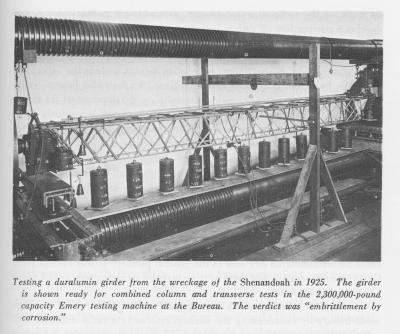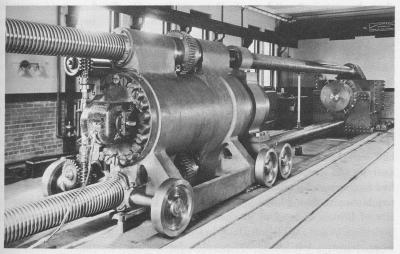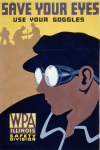Caption: 'Testing a duralumin girder from the wreckage of the Shenandoah in 1925. The girder is shown ready for combined column and transverse tests in the 2,300,000-pound capacity Emery testing machine at the Bureau [US National Bureau of Standards]. The verdict was "embrittlement by corrosion."' [p. 285]
Text:
[p. 284] 'Structural specimins from the wreckage,
sent to the Bureau for examination,
revealed widespread corrosion,
yet insufficient, it seemed, to cause her destruction.
American-made duralumin was found to have a fatal flaw:
with time it became brittle.
"Embrittlement by corrosion,"
the Bureau described it.188
Experimentation indicated it could be made durable by applying
[p. 285]
a protective coating of aluminum,
but the last two U.S. dirigibles were not to survive long enough
to prove the coating.
Although the German-built Los Angeles flew for 9 years
before it was decommissioned in 1932,
neither the Navy's 785-foot Akron (ZR-4),
completed in 1931,
nor her sister ship the Macon (ZR-5),
ready in 1933,
lasted 2 years beyond their maiden flights.189'
[Original footnotes:
'[p. 284] 188
T270, "An analysis of the deformation of the mooring spindle of the
Shenandoah"
(Tuckerman and Aitchison, 1925);
editorial, "Deterioration of duralumin in the Shenandoah,"
Eng. News-Record, 95, 1000 (1925);
NBS Annual Report 1926, pp. 8-9;
Annual Report 1927, p. 41.'
'[p. 285] 189
See John Toland, Ships in the Sky (New York: Holt, 1957), passim.
Germany's Graf Zeppelin lasted almost 10 years before it
was decommissioned in 1938, but the explosion of the
Hindenberg while landing at Lakehurst that same year put an end
to further investment in sky queens.']



